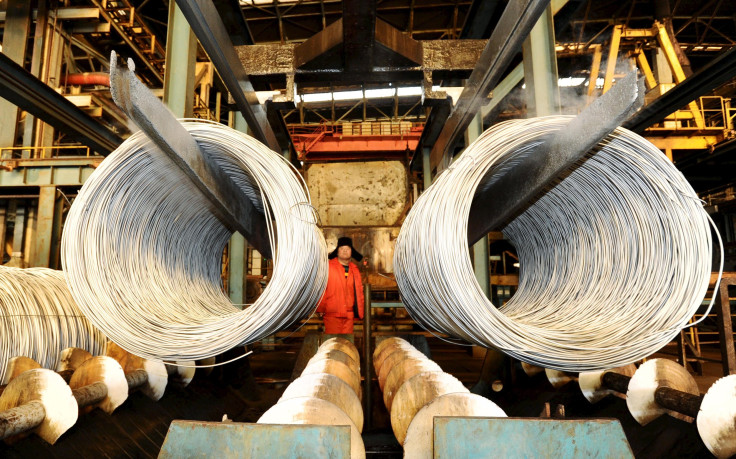China’s Economy ‘Still Slowing’ As Caixin PMI Index Suggests Output Contracted Again

SHANGHAI — China’s manufacturing data for April appears to confirm that, despite signs of a stabilization in the first quarter, it is too early to speak of a recovery for the world’s second-largest economy, experts said Tuesday.
The Caixin Markit Purchasing Managers’ Index, which measures activity in China’s smaller and private industrial companies, fell back to 49.4 (in an index where figures below 50 indicate a contraction in the sector). It follows a sharp rise, albeit only to 49.7, in March.
The data, which are well below a market consensus of 49.9, follow official figures released at the weekend measuring activity at larger and state-owned enterprises, which tend to show more optimistic results — these remained in positive territory at 50.1 but also fell back from March’s 50.2. (The index previously contracted for seven straight months to February.)
Some experts had argued that the sharp upswing in March was partly affected by seasonal factors, as companies returned to work after February’s Chinese New Year vacation. And Dr. He Fan, chief economist for Chinese financial publication Caixin, which compiled the latest data, said the figures suggested China's economy was “still slowing.”
“These fluctuations indicate the economy lacks a solid foundation for recovery and is still in the process of bottoming out. ... The government has to keep a close watch on risks of a further economic downturn," Caixin's He said.
China’s overall growth slowed to 6.7 percent in the first quarter of this year, from 6.8 percent in the final quarter of 2015, and 6.9 percent for last year as a whole.

Some grounds for optimism had been seen in a rebound in industrial production in March, and a rebound in exports, which Caixin's He said at the time was a sign that “government stimulus polices have begun to take hold.” However, HSBC China economist Julia Wang said in a research note sent to International Business Times Tuesday that China's overall April output “fell back to contractionary territory.” And, Caixin added that new export orders for the companies it surveyed fell in April, while total new orders "stagnated."
It also noted that employment in the manufacturing sector contracted sharply, after improving in March, with "the rate of job-shedding ... only marginally less dramatic than February's cuts, which were the worst in seven years.” Caixin said some companies were “downsizing and others choosing not to fill vacant positions.”
The Caixin report added that both input and output prices rose in March, with China's inflation at its highest level for more than three years. And, it said rising input prices were adding to cost pressures for producers, with the increase in manufacturing prices the sharpest since October 2011. But HSBC’s Wang said this indicator also gave grounds for optimism.
“Prices held up relatively well, as the stabilization in international commodity prices as well as domestic primary commodity prices have helped to support producers' margins,” she wrote.
And, Wang argued that despite weakening indicators, the April PMI data “do not suggest a sharp reversal as some market participants have feared.” She noted that inventories of unsold products have continued to decline, reaching their lowest level since February 2009, leaving HSBC’s “growth momentum indicator [new orders minus inventory]” at its highest level since February 2011. Wang said this indicated continuing need for “restocking,” or further production, by manufacturers, adding that this “should keep activities supported in the coming months.”
But she said that the data showed China’s large and small enterprises were doing less well than medium-sized ones — in a sign that less competitive state-run firms and private companies in low-value added industries alike are still facing challenging times ahead.

The Chinese government has said it is seeking to re-balance the economy toward high-tech industry and the service sector, with the latter currently the biggest creator of jobs. Caixin’s data for the service sector is due to be released on Thursday. The government’s own data for the service sector, while remaining firmly in expansionary territory at 53.5 in April, also weakened after a sharp rise to 53.8 in March — though employment in the sector is still growing.
The Chinese government has also sought to boost the economy via expanding credit, particularly for the housing sector, as well as increasing infrastructure spending. But while a rapid revival in housing sales “helped lead China’s recovery” in March, according to HSBC’s Wang, the government has now tightened controls on lending in some parts of the country, and cracked down on gray-market loans that were allowing some to buy homes without even paying a deposit.
“We still need to watch out for the impact of macro-prudential tightening on the housing market,” Wang said in her latest report.
She said continued fiscal easing — spending and tax cuts — to support infrastructure investment was required to sustain the recovery. But with some observers warning that the level of credit in China is reaching dangerous levels, following data showing a rise in the proportion of nonperforming loans at China’s banks in recent months, a new report from consultancy Oxford Economics predicted that, while China would carry out some further monetary easing this year, it would not make further cuts in interest rates to stimulate borrowing in the coming months. (Beijing previously cut interest rates six times between late 2014 and the end of 2015.)
© Copyright IBTimes 2024. All rights reserved.












